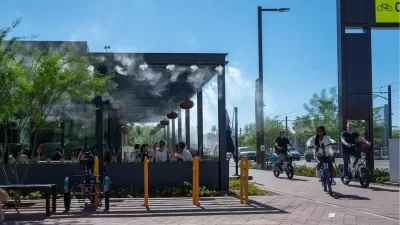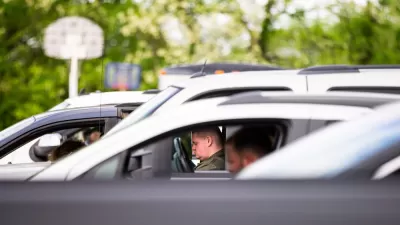Despite initial skepticism about its true potential for sustainable urbanism, the built-from-scratch “car-free neighborhood” is widely popular with its residents.

Culdesac Tempe, which billed itself as the nation’s first ground-up car-free neighborhood, seems to be a success for its residents, writes Ben Ikenson in Dwell.
With the first phase finished last year, the high-profile development continues to unfold on a 17-acre site along a light rail line in an established neighborhood about 15 miles east of downtown Phoenix. The $200 million project now includes 288 apartment units with about 300 tenants, reeling residents in with appeals of a healthier, more eco-friendly lifestyle, built-in community with ample amenities, and accessible transit to Tempe and the greater metro area.
According to Ikenson, the neighborhood received criticism for being relatively isolated and, according to Strong Towns, not “the incremental urbanism and thickening our cities need.” (Later, Strong Towns revised its opinion, noting “We all have a hand in building strong towns, and it can take many different forms. We’re here to celebrate every effort.”)
Residents seem satisfied with the neighborhood’s walkability, amenities, and transit access. The community offers free e-bikes and transit passes — and residents actually use them. Residents also say rents are reasonable, with studios starting at $1,300 per month in a region where median rent for a studio is $1,375.
Kevin DeGood, director of infrastructure policy at the Center for American Progress, acknowledged the community’s success, noting, “We need more housing and land use experimentation, not less. And bold experiments like Culdesac show there is real demand for alternatives.”
FULL STORY: America’s “First Car-Free Neighborhood” Is Going Pretty Good, Actually?

Planetizen Federal Action Tracker
A weekly monitor of how Trump’s orders and actions are impacting planners and planning in America.

San Francisco's School District Spent $105M To Build Affordable Housing for Teachers — And That's Just the Beginning
SFUSD joins a growing list of school districts using their land holdings to address housing affordability challenges faced by their own employees.

The Tiny, Adorable $7,000 Car Turning Japan Onto EVs
The single seat Mibot charges from a regular plug as quickly as an iPad, and is about half the price of an average EV.

Seattle's Plan for Adopting Driverless Cars
Equity, safety, accessibility and affordability are front of mind as the city prepares for robotaxis and other autonomous vehicles.

As Trump Phases Out FEMA, Is It Time to Flee the Floodplains?
With less federal funding available for disaster relief efforts, the need to relocate at-risk communities is more urgent than ever.

With Protected Lanes, 460% More People Commute by Bike
For those needing more ammo, more data proving what we already knew is here.
Urban Design for Planners 1: Software Tools
This six-course series explores essential urban design concepts using open source software and equips planners with the tools they need to participate fully in the urban design process.
Planning for Universal Design
Learn the tools for implementing Universal Design in planning regulations.
Smith Gee Studio
City of Charlotte
City of Camden Redevelopment Agency
City of Astoria
Transportation Research & Education Center (TREC) at Portland State University
US High Speed Rail Association
City of Camden Redevelopment Agency
Municipality of Princeton (NJ)





























